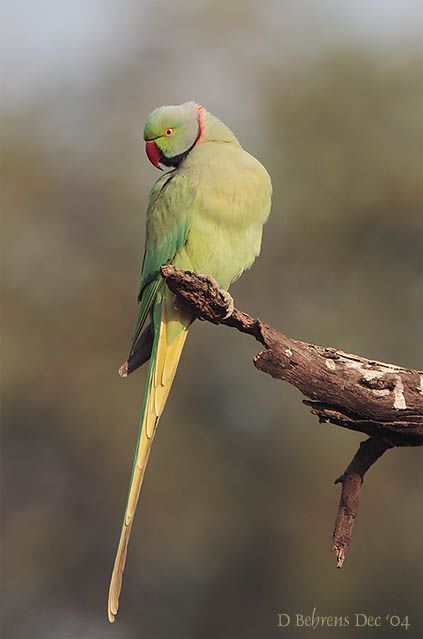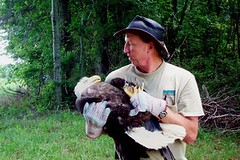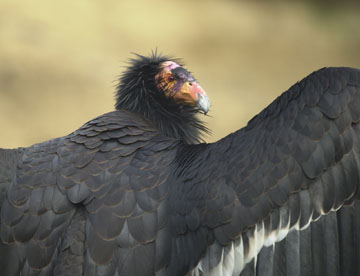Birds in the News #27

Indian ring-necked parakeet, Psittacula krameri.
Their feral populations are increasing dramatically in Britain
(link below).
Birds in Science:
Why are male birds generally more colorful than female birds? In this free online Scientific American article, we learn more about the evolution of morphology and behavior in birds with complex social behaviors and breeding systems. This article also discusses the lovely Eclectus parrots, where the scarlet-and-blue female is much more brightly colored than the emerald-green male. The article discusses what this phenomenon teaches us about their social behaviors.
British farmland bird populations have been declining for 50 years and the accepted explanation is the intensification of agriculture. Based on the fact that some species have survived better than others, researchers looked for specific characteristics that influenced survival rates. Intelligence made the biggest difference in survival rates, according to this story, published yesterday in the peer-reviewed scientific journal, Proceedings of the Royal Society B: Biological Sciences. "There does seem to be a positive advantage to these birds in being smart," said Tim Blackburn, an ecologist at the University of Birmingham. "The size of the brain influences the probability that these farmland birds are declining."
People Helping Birds:
It appears that the United Kingdom is having trouble with an invasion of parrots. In fact, the exotic invaders are now so numerous they are known as "posh pigeons". The feral parrot population has exploded in Britain: according to the latest scientific survey, the British population of Indian ring-necked parakeets, Psittacula krameri [pictured at top], is increasing by 30 per cent a year, and is likely to reach 100,000 by the end of the decade. Additionally, monk (Quaker) parakeets, Myiopsitta monachus, have been spotted in Hertfordshire and Devon, Alexandrine parakeets, Psittacula eupatria, have set up home in Merseyside, and orange-winged parakeets, Brotogeris pyrrhopterus, originally from the Amazon, have settled in Weybridge. Chris Butler, a biologist at the Edward Grey Institute in Oxford, has studied the parakeet population and now believes that they can no longer be controlled. But so far, there is no firm evidence that the parrots are muscling out other species, as are the invasive grey squirrel and the mink, but Mike Toms, of the British Trust for Ornithology, said that they tended to nest in the same places as native bird species, only earlier. “We need to be aware of the possible impact,” he said. “They nest in quite large cavities so they would be competing with birds like tawny owls and jackdaws.”
Teams from as far afield as Los Angeles and San Diego are traveling around the New Orleans area, wading into flooded areas and checking abandoned neighborhoods to rescue animals that could not accompany their owners. There are now more than 4,000 pets in a temporary shelter in nearby Gonzales, and there is nowhere left to take rescued animals. "It is packed to the gills," said Kim Noetzel in a telephone interview. Noetzel is the marketing director of the Arizona Humane Society, which is trying to help coordinate efforts. The teams were finally able to get into badly flooded St. Bernard parish this week for the first time and found many animals had drowned. Even though many people heeded mandatory evacuation order before Katrina hit, they left pets with several days' food and water, expecting to return quickly. Instead, they have been gone since the end of August and their pets have been locked into houses with no power, no air conditioning, with temperatures above 90 degrees F (32 C) daily. Pet owners were trying desperately to get to their animals or organize a rescue. Some evacuees found neighbors to return and check on their animals, while others posted pleas on Web sites such as petfinder.org. GrrlScientist notes: There are some successful rescues worthy of mention. For example, a flock of 50 budgerigars trapped in a house in New Orleans were recently evacuated to Baton Rouge. Thanks to the coordinated efforts of aviculturists and especially a local police officer, who took a bucket of seed to the birds from someone whom they wouldn't allow into the area, thirty-eight birds survived and are now being housed and cared for by an officer of the American Budgerigar Society.
People Hurting Birds:
 One adult female bald eagle, Haliaeetus leucocephalus, is fueling a debate regarding limits on power plants in the state of Indiana. The bird was easily captured when it was unable to fly. Tests revealed that she was suffering from mercury poisoning. It turns out that Indiana power plants emit the fourth-greatest volume of mercury in the nation, according to a report this week from a national environmental group. But the significance of the eagle's health problems, however, is up for debate. "To me, this eagle is sending a very strong message that people should pay attention to," said Catherine Bowe, a mercury campaign manager at the National Wildlife Federation. She said Indiana is known for high mercury levels in fish, and "it's time to take mercury real seriously; it's scary stuff and it doesn't go away." But others aren't so sure: Indiana natural resources officials have no way of knowing whether the eagle's mercury levels were caused by eating Indiana fish.
One adult female bald eagle, Haliaeetus leucocephalus, is fueling a debate regarding limits on power plants in the state of Indiana. The bird was easily captured when it was unable to fly. Tests revealed that she was suffering from mercury poisoning. It turns out that Indiana power plants emit the fourth-greatest volume of mercury in the nation, according to a report this week from a national environmental group. But the significance of the eagle's health problems, however, is up for debate. "To me, this eagle is sending a very strong message that people should pay attention to," said Catherine Bowe, a mercury campaign manager at the National Wildlife Federation. She said Indiana is known for high mercury levels in fish, and "it's time to take mercury real seriously; it's scary stuff and it doesn't go away." But others aren't so sure: Indiana natural resources officials have no way of knowing whether the eagle's mercury levels were caused by eating Indiana fish. 
This story reveals more details about the glass shards and metal scraps (linked earlier) that have killed or threatened two of the three California condor chicks, Gymnogyps californianus, born this year in the wild. The third was only days away from becoming the first wild condor fledgling in California in 20 years. For the past three years, wild condor hatchlings have died after ingesting large amounts of trash. Last month, a chick brought in with a broken wing was found with a record 35 bottle caps in its stomach. In 2002, all three chicks that hatched in California died about a month shy of their anticipated fledge dates. While cause of death was unknown for two of the birds, the third died of zinc poisoning after ingesting electrical fixtures, screws, and washers coated with the heavy metal. In 2003, the state's only wild chick exhibited stunted growth after ingesting large amounts of trash, including an 18-inch rag, and had to be euthanized after jagged glass shards perforated its stomach, causing respiratory damage resulting in pneumonia. Although some ornithologists think the birds mistake trash for bone shards that they rely on for necessary calcium, biologists are unsure why condor parents are feeding trash to their young. "It's a huge problem," said Allan Mee, a wildlife biologist with the San Diego Zoo. "You can pump out as many captive-bred chicks as you want, but if you can't get them to reproduce in the wild, the rest is inconsequential."
Political Birds:
For some mysterious reason, religious conservatives have adopted the second highest-grossing documentary film in history, March of the Penguins, as evidence for so-called "intelligent design", and also as support for monogamy and against gay marriage, etc. Fortunately, not all conservatives are blinded by zealotry. "If an Intelligent Designer designed nature," the columnist George F. Will asked recently, "why did it decide to make breeding so tedious for those penguins?" GrrlScientist agrees and adds: Penguins are not as monogamous as the christian right-wingers would have you believe. Penguins will often have a different mate for each chick/breeding season. Is this what christians want their kids to emulate? On to a different but related topic; anything that we don't understand could be called miraculous simply because we don't understand it. But science provides the understanding that we seek. As we develop a deeper understanding of the world and her creatures, the more amazing, fascinating and awe-inspiring this world becomes. Penguins are merely one example of this (an excellent example, nonetheless).
Avian Disease News:
 This article tells the story about a 43-year-old China-born virus-hunter, Yi Guan, who works at the University of Hong Kong. "When I am not sleeping, I am working, most of the time on the H5N1," said Yi. He got acquainted with the bug in 1997 when it made its first known jump to humans in Hong Kong, where it killed six people. And since 2000, Guan has been able to track its spread all over China after testing more than 100,000 stool samples from domestic chickens, aquatic and wild birds. "We should have stopped it when it was still (in poultry) within China. The best opportunity to contain it was between 1997 and 2001, before the big explosion in 2003," Yi said, referring to the rapid spread of the virus from late 2003 in southeast Asia, where the H5N1 is now endemic in poultry. Experts fear the virus will unleash the next pandemic and kill millions of people. [Pictured: map of reported avian influenza outbreaks in Asia.]
This article tells the story about a 43-year-old China-born virus-hunter, Yi Guan, who works at the University of Hong Kong. "When I am not sleeping, I am working, most of the time on the H5N1," said Yi. He got acquainted with the bug in 1997 when it made its first known jump to humans in Hong Kong, where it killed six people. And since 2000, Guan has been able to track its spread all over China after testing more than 100,000 stool samples from domestic chickens, aquatic and wild birds. "We should have stopped it when it was still (in poultry) within China. The best opportunity to contain it was between 1997 and 2001, before the big explosion in 2003," Yi said, referring to the rapid spread of the virus from late 2003 in southeast Asia, where the H5N1 is now endemic in poultry. Experts fear the virus will unleash the next pandemic and kill millions of people. [Pictured: map of reported avian influenza outbreaks in Asia.]San Diego Zoo tests confirmed that a 3-month-old California condor, Gymnogyps californianus, in Ventura County died of West Nile virus. The chick is the only condor known to be infected among the 120 endangered birds living in three breeding populations in western North America, Marc Weitzel, a condor recovery project leader, said in the report, published in the Los Angeles Times. "We've been concerned that the virus could hit the program, and now it has," Weitzel said. The chick died Aug. 25, shortly after biologists retrieved it from a nest near the Hopper Mountain National Wildlife Refuge. US Fish and Wildlife Service Field Notes about the California condor program.
Streaming Birds:
Featured this week on the popular radio show, BirdNote; Why Dippers Dip; Eagles Do a Fall Walkabout; The Mystique of the Albatross; Shearwaters Swarm the Coast; and Ravens and Crows - Who's Who? BirdNote shows are two-minute vignettes that incorporate the rich sounds of birds with stories that illustrate the interesting -- and in some cases, truly amazing -- abilities of birds. BirdNote can be heard Monday through Friday, 8:58-9:00AM, throughout Western Washington and Southwest British Columbia and is also available as RSS/Podcast feeds.
Miscellaneous Birds:
What does the red-necked stint and the Cebu flowerpecker have in common with Supreme Court Justices? Read this story to learn more!
Have you always wanted your phone to cackle like a kookaburra or roar like a lion instead of making that annoying ring? Well, now it can because you can purchase a wildlife ring tone for your cell phone.
Thanks to my bird pals Diann, Ian, Mary, Caren, Ellen and Ron for some of the links you are reading here.
Previous : : Birds in the News : : Next
Academic Jobs: 1 interview request for a tenure-track position. (After talking to me, the caller removed my name from the interview schedule).
© 2004, 2005, 2006 by GrrlScientist











5 Peer Reviews:
Thanks for another weekly report of bird news.
Guess the neo-cons haven't heard about Wendell and Cass. http://www.jrn.columbia.edu/studentwork/cns/2002-06-10/591.asp
Oh, thanks for that link! Even though the story is old, it is still relevant and interesting, and I shall most certainly put that into next week's Birds in the News.
GrrlScientist
Re: March of the Penguins...
You know I love that movie. Recently, I was educating some young bloggers of faith in a slugfest of comments and came up with this:
I sit at the center of my perceptible world. All around me are things I can define through sensory perception and abstract thought. Everything nearby I can define: "Brownies!" everything in the distance I can ponder: "Art! Sun! Moon!" and everything I haven't yet understood I can have faith in: "Danger! Love! Magic! God!". As I get older, the things I can define grow more numerous, my world grows larger, and more and more things I used to have faith in are instead explainable and definitive... "Oh, that's not magic, that's just a puff of smoke created by a chemical reaction..." But I won't live long enough to fully explain everything, so God (or Love, or Danger, or Nature, or whatever I choose as a catch-all) will always have a place. Luckily, there are people not satisfied with "Oh... well that's God" or we'd still be in the Dark Ages with an average lifespan of 31 years.
This section of your entry reminded me of that, and I thought I'd remind you that like minds abound. :)
Always fascinating reading, thank you.
That picture of the eagle being carried just breaks my heart. I could go on a rampaging rant about how we are poisoning and killing everything that is beautiful and wild. But, I'd just be preaching to the choir.
As always a great round up of the birds in the news.
Hope your school year is turning out to be a good one.
That parakeet photo is lovely! And sexual dichromaticism is soooo cool. Not sure what to make of the Onion article about Roberts, but I think it's safe to say that anybuddy into birds can't, by definition, be a total ass, so Roberts probably don't like birds.
And good point in your comment, Brian. Wish more would get a grasp on that line of thinking.
Hedwig, sympathy regarding your employment aside, I'm betting at least your students are in good hands. FWIW, keep that in mind.
Post a Comment
<< Home